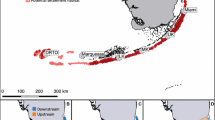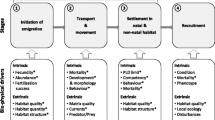Abstract
The persistence and resilience of marine populations in the face of disturbances is directly affected by connectivity among populations. Thus, understanding the magnitude and pattern of connections among populations and the temporal variation in these patterns is critical for the effective management and conservation of marine species. Despite recent advances in our understanding of marine connectivity, few empirical studies have directly measured the magnitude or pattern of connections among populations of marine fishes, and none have explicitly investigated temporal variation in demographic connectivity. We use genetic assignment tests to track the dispersal of 456 individual larval fishes to quantify the extent of connectivity, dispersal, self-recruitment and local retention within and among seven populations of a coral reef fish (Stegastes partitus) over a three-year period. We found that some larvae do disperse long distances (~200 km); however, self-recruitment was a regular phenomenon. Importantly, we found that dispersal distances, self-recruitment, local retention and the pattern of connectivity varied significantly among years. Our data highlight the unpredictable nature of connectivity, and underscore the need for more, temporally replicated, empirical measures of connectivity to inform management decisions.



Similar content being viewed by others
References
Almany GR, Berumen ML, Thorrold SR, Planes S, Jones GP (2007) Local replenishment of coral reef fish populations in a marine reserve. Science 316:742–744. doi:10.1126/science.1140597
Becker BJ, Levin LA, Fodrie FJ, McMillan PA (2007) Complex larval connectivity patterns among marine invertebrate populations. Proc Natl Acad Sci USA 104:3267–3272. doi:10.1073/pnas.0611651104
Berry O, Tocher MD, Sarre SD (2004) Can assignment tests measure dispersal? Mol Ecol 13:551–561. doi:10.1046/j.1365-294X.2004.02081.x
Bjornstad G, Roed KH (2002) Evaluation of factors affecting individual assignment precision using microsatellite data from horse breeds and simulated breed crosses. Anim Gen 33:264–270. doi:10.1046/j.1365-2052.2002.00868.x
Botsford LW et al (2009) Connectivity and resilience of coral reef metapopulations in marine protected areas: matching empirical efforts to predictive needs. Coral Reefs 28:327–337. doi:10.1007/s00338-009-0466-z
Bradbury IR, Laurel B, Snelgrove PVR, Bentzen P, Campana SE (2008) Global patterns in marine dispersal estimates: the influence of geography, taxonomic category and life history. Proc R Soc Lond B 275:1803–1809. doi:10.1098/rspb.2008.0216
Carlsson J (2008) Effects of null alleles on assignment testing. J Hered 99:616–623. doi:10.1093/jhered/esn048
Christie MR, Johnson DW, Stallings CD, Hixon MA (2010) Self-recruitment and sweepstakes reproduction amid extensive gene flow in a coral-reef fish. Mol Ecol 19:1042–1057. doi:10.1111/j.1365-294X.2010.04524.x
Cowen RK, Paris CB, Srinivasan A (2006) Scaling of connectivity in marine populations. Science 311:522–527. doi:10.1126/science.1122039
Eckert GL (2003) Effects of the planktonic period on marine population fluctuations. Ecology 84:372–383. doi:10.1890/0012-9658(2003)084[0372:EOTPPO]2.0.CO;2
Elphinstone MS, Hinten GN, Anderson MJ, Nock CJ (2003) An inexpensive and high-throughput procedure to extract and purify total genomic DNA for population studies. Mol Ecol Notes 3:317–320. doi:10.1046/j.1471-8286.2003.00397.x
Fisher R, Bellwood DR (2003) Undisturbed swimming behaviour and nocturnal activity of coral reef fish larvae. Mar Ecol Prog Ser 263:177–188. doi:10.3354/meps263177
Fogarty MJ, Botsford LW (2007) Population connectivity and spatial management of marine fishes. Oceanogr 20:112–123
Hedgecock D (1994) Temporal and spatial genetic structure of marine animal populations in the California Current. Calif Coop Ocean Fish Inv 35:73–81
Hepburn RI, Sale PF, Dixon B, Heath DD (2009) Genetic structure of juvenile cohorts of bicolor damselfish (Stegastes partitus) along the Mesoamerican barrier reef: chaos through time. Coral Reefs 28:277–288. doi:10.1007/s00338-008-0423-2
Hogan JD, Thiessen RJ, Heath DD (2010) Variability in connectivity indicated by chaotic genetic patchiness within and among populations of a marine fish. Mar Ecol Prog Ser 417:263–275. doi:10.3354/meps08793
Holland MD, Hastings A (2008) Strong effect of dispersal network structure on ecological dynamics. Nature 456:792–794. doi:10.1038/nature07395
Hutchings JA (2000) Collapse and recovery of marine fishes. Nature 406:882–885. doi:10.1038/35022565
Jackson JBC et al (2001) Historical overfishing and the recent collapse for coastal ecosystems. Science 293:629–638. doi:10.1126/science.1059199
Johnson MS, Black R (1984) The Wahlund effect and the geographical scale of variation in the intertidal limpet Siphonaria sp. Mar Biol 79:295–302
Jones GP, Milicich MJ, Emslie MJ, Lunow C (1999) Self-recruitment in a coral reef fish population. Nature 402:802–804. doi:10.1038/45538
Jones GP, Planes S, Thorrold SR (2005) Coral reef fish larvae settle close to home. Curr Biol 15:1314–1318. doi:10.1016/j.cub.2005.06.061
Jones GP, Srinivasan M, Almany GR (2007) Population connectivity and conservation of marine biodiversity. Oceanogr 20:100–111
Jones GP et al (2009) Larval retention and connectivity among populations of corals and reef fishes: history, advances and challenges. Coral Reefs 28:307–325. doi:10.1007/s00338-009-0469-9
Larson RJ, Julian RM (1999) Spatial and temporal genetic patchiness in marine populations and their implications for fisheries management. Cal Coop Ocean Fish 40:94–99
Leis JM (1991) The pelagic stage of reef fishes: the larval biology of coral reef fishes. In: Sale PF (ed) The ecology of fishes on coral reefs. Academic, San Diego, pp 183–230
Levin LA (2006) Recent progress in understanding larval dispersal: new directions and digressions. Integr Comp Biol 46:282–297. doi:10.1093/icb/024
Miller JA, Shanks AL (2004) Evidence for limited larval dispersal in black rockfish (Sebastes melanops): implications for population structure and marine reserve design. Can J Fish Aquat Sci 61:1723–1735. doi:10.1139/f04-111
Myrberg AA (1972) Ethology of the bicolor damselfish, Eupomacentrus partitus: a comparative analysis of laboratory and field behaviour. Anim Behav Monogr 5:197–283
Ospina-Guerrero SP, Landinez-Garcia RM, Rodriguez-Castro DJ, Arango R, Marquez E (2008) Genetic connectivity of Stegastes partitus in the south Caribbean evidenced by microsatellite analysis. Cien Mar 34:155–163
Paetkau D, Slade R, Burden M, Estoup A (2004) Genetic assignment methods for the direct, real-time estimation of migration rate: a simulation-based exploration of accuracy and power. Mol Ecol 13:55–65. doi:10.1046/j.1365-294X.2003.02008.x
Planes S, Jones GP, Thorrold SR (2009) Larval dispersal connects fish populations in a network of marine protected areas. Proc Natl Acad Sci USA 106:5693–5697. doi:10.1073/pnas.0808007106
Purcell JFH, Cowen RK, Hughes CR, Williams DA (2009) Population structure in a common Caribbean coral-reef fish: implications for larval dispersal and early life history traits. J Fish Biol 74:403–417. doi:10.1111/j.1095-8649.2008.02078.x
Rannala B, Mountain JL (1997) Detecting immigration by using multilocus genotypes. Proc Natl Acad Sci USA 94:9197–9201
Robertson DR, Green DG, Victor BC (1988) Temporal coupling of production and recruitment of larvae of a Caribbean reef fish. Ecology 69:370–381
Salas E, Molina-Urena H, Walter RP, Heath DD (2010) Local and regional genetic connectivity in a Caribbean coral reef fish. Mar Biol 157:437–445. doi:10.1007/s00227-009-1330-y
Sale PF (1980) The ecology of fishes on coral reefs. Oceanogr Mar Biol Ann Rev 18:367–421
Sale PF et al (2005) Critical science gaps impede use of no-take fishery reserves. Trends Ecol Evol 20:74–80. doi:10.1016/j.tree.2004.11.007
Selkoe KA, Gaines SD, Caselle JE, Warner RR (2006) Current shifts and kin aggregation explain genetic patchiness in fish recruits. Ecology 87:3082–3094. doi:10.1890/0012-9658(2006)87[3082:CSAKAE]2.0.CO;2
Shima JS, Swearer SE (2009) Larval quality is shaped by matrix effects: implications for connectivity in a marine metapopulation. Ecology 90:1255–1267. doi:10.1890/08-0029.1
Soto I et al (2009) Physical connectivity in the Mesoamerican barrier reef system inferred from 9 years of ocean color observations. Coral Reefs 28:415–425. doi:10.1007/s00338-009-0465-0
Swearer SE, Caselle JE, Lea DW, Warner RR (1999) Larval retention and recruitment in an island population of a coral reef fish. Nature 402:799–802. doi:10.1038/45533
Tang LQ, Sheng JY, Hatcher BG, Sale PF (2006) Numerical study of circulation, dispersion, and hydrodynamic connectivity of surface waters on the Belize shelf. J Geophys Res Oceans 111. doi:10.1029/2005JC002930
Thiessen RJ, Heath DD (2007) Characterization of one trinucleotide and six dinucleotide microsatellite markers in bicolor damselfish, Stegastes partitus, a common coral reef fish. Conserv Genet 8:983–985. doi:10.1007/s10592-006-9207-9
Thorrold SR et al (2002) Quantifying larval retention and connectivity in marine populations with artificial and natural markers. Bull Mar Sci 70:291–308
Villegas-Sanchez CA, Rivera-Madrid R, Arias-Gonzalez JE (2010) Small scale genetic connectivity of bicolor damselfish (Stegastes partitus) recruits in Mexican Caribbean reefs. Coral Reefs 29:1023–1033. doi:10.1007/s00338-010-0643-0
Walter RP, Aykanat T, Kelly DW, Shrimpton JM, Heath DD (2009) Gene flow increases temporal stability of Chinook salmon (Oncorhynchus tshawytscha) populations in the Upper Fraser River, British Columbia, Canada. Can J Fish Aquat Sci 66:167–176. doi:10.1139/F08-201
Waples RS, Gaggiotti O (2006) What is a population? An empirical evaluation of some genetic methods for identifying the number of gene pools and their degree of connectivity. Mol Ecol 15:1419–1439. doi:10.1111/j.1365-294X.2006.020890.x
Wellington GM, Victor BC (1989) Planktonic larval duration of one hundred species of Pacific and Atlantic damselfishes (Pomacentridae). Mar Biol 101:557–567
Williams DA, Purcell J, Hughes CR, Cowen RK (2003) Polymorphic microsatellite loci for population studies of the bicolor damselfish, Stegastes partitus (Pomacentridae). Mol Ecol Notes 3:547–549. doi:10.1046/j.1471-8286.2003.00506.x
Wright S (1931) Evolution in Mendelian populations. Genetics 16:97–158
Acknowledgments
This work was supported by the Global Environment Facility-funded University of Queensland and World Bank project Coral Reef Targeted Research for Capacity Building and Management, by a Natural Sciences and Engineering Research Council Tier I Canada Research Chair grant to D.D.H., as well as a GLIER postdoctoral fellowship from the University of Windsor to J.D.H. We thank the University of Belize, Institute of Marine Studies, and D. Campbell-Smith for logistical support during the field collections; P. Usseglio, E. Salas, D. Hasselman and R. Walter for help with field collections; S. Jaimeson and R. Walter for statistical help; R. Walter for discussion; and S. Jamieson, S. Ellis, R. Walter, T. Pitcher, S. Planes and anonymous reviewers for comments on the manuscript.
Author information
Authors and Affiliations
Corresponding author
Additional information
Communicated by Craig Osenberg.
Electronic supplementary material
Below is the link to the electronic supplementary material.
Rights and permissions
About this article
Cite this article
Hogan, J.D., Thiessen, R.J., Sale, P.F. et al. Local retention, dispersal and fluctuating connectivity among populations of a coral reef fish. Oecologia 168, 61–71 (2012). https://doi.org/10.1007/s00442-011-2058-1
Received:
Accepted:
Published:
Issue Date:
DOI: https://doi.org/10.1007/s00442-011-2058-1




